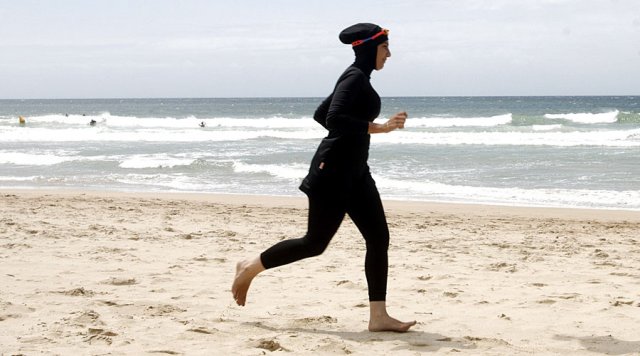
A fight broke out on a beach on the French island of Corsica on August 13 after a tourist began taking photos of women wearing burqinis. Following the altercation, the local mayor decided to ban the full-body swimwear.
That's right: someone took photos of women without their permission, people got upset and, in response, the state is now dictating what women can and cannot wear.
This reactionary ban has now been extended to Cannes and Villeneuve-Loubet, with Le Touquet, on the Atlantic coast, to follow. Women caught wearing a burqini are liable for a €38 fine ($56) if they refuse to change or leave the beach.
Of course the excuses for this policing of women's bodies are endless: “it's a sensitive debate”, “France has suffered more than one deadly Islamic terrorist attacks.” They are all attempts to justify the French state telling women what they can and cannot wear.
Conservative mayors who have imposed the ban claim the burqini defies French laws on secularism.
The 2004 French law on secularity and conspicuous religious symbols in schools bans the wearing of religious symbols in public schools. While the law does not mention any specific religion, it is considered by many to be directed at Muslim school girls wearing the hijab.
It is regularly referred to in the international media as the “French headscarf ban”.
Some feminists who view the hijabs, niqabs, burqas and burqinis as oppressive to women have come out in support of the ban on these garments. However, one would hope that most feminists see this clothing ban for what it is: misogynist and racist.
Dictating in law what women can and cannot wear, or how they can and cannot express their religious beliefs, is state-sponsored sexism. It is yet another example of women bearing the brunt of racist, dog whistle politics.
The same debate occurred here in Australia, though thankfully no ban was implemented.
In 2014, Tasmanian Senator Jackie Lambie led a charge to ban the burqa inside Parliament House. The hysteria around women wearing burqas in Parliament House was accompanied by video footage of women wearing niqabs and hijabs, leading to confusion around what exactly Lambie wanted banned.
For some clarification around different types of head coverings click here.
Due to the backlash in many countries against Muslim women, for many, their head covering has become more than just about their religion.
The Los Angeles Times recently posted a video called “My hijab is my voice”, which interviewed women in the United States about why they chose to wear a head scarf and what it means to them.
Many women spoke about the pressure to stop wearing the head scarf in light of growing Islamophobia.
One young woman said: “I want to prove to myself that I am as strong as I think I am. I feel like Muslim women who wear the hijab in this country are a symbol of strength and I want to be a part of that”. Another young woman spoke of wearing the hijab as a way of resisting mainstream culture.
The Islamophobia Register Australia was founded in September 2014 to document Islamophobic attacks and violence.
A preliminary findings report released in December 2015 found that Islamophobic violence had increased three-fold since the Paris attacks, and that the victims of this violence were predominantly women wearing religious headwear.
The federal government is currently spending millions of dollars on an anti-terrorism advertising campaign to promote the message “If it doesn't add up, speak up”. In Victoria, the state government is running a similar campaign with the message “If you see something, say something”.
If governments are truly interested in preventing terrorism and violence, they could start by investing millions in a campaign to raise awareness around racism and Islamophobia.
“If you see a bigot, say something” has a nice ring to it.
Like the article? Subscribe to Green Left now! You can also like us on Facebook and follow us on Twitter.